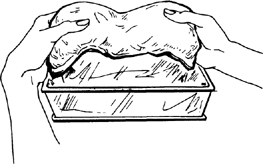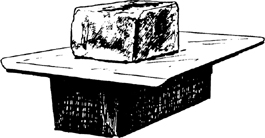Mastering the Art of French Cooking, Volume 2 (37 page)
Read Mastering the Art of French Cooking, Volume 2 Online
Authors: Julia Child

| Place the dough smooth side up in the prepared pan, pressing it down snugly into the corners with your knuckles |
(*) You can
freeze the dough
at this point, wrapping pan airtight. To continue with the recipe, let thaw for several hours in the refrigerator or at room temperature.
For the final rising, set pan uncovered at a temperature of 75 to 80 degrees until dough has risen to slightly more than double, or to fill the pan by no more than ¾. It is important when you are to bake in a covered pan that you do not let the dough rise more than this, as it must have room to finish swelling and to fill the pan while it is in the oven. When dough has risen, bake at once.
(*) You can delay the rising action by setting the pan in the refrigerator, or even by weighting it down under refrigeration. In either case, the pan should be covered airtight, then set uncovered at room temperature for 20 to 30 minutes before baking. If dough has over-risen, bake it uncovered or deflate by pressing it down and letting it rise again to the correct height.
7) Baking, cooling, and storing—oven at 435 degrees; baking time 40 minutes
A perfectly smooth sheet of aluminum foil 1½ inches larger all around than bread pan, and greased on shiny side
A baking sheet or a pan large enough to cover entire top of bread pan
A 5-pound weight of some sort, such as a brick
A cake rack, for cooling bread after baking
Oven has been preheated to 435 degrees. Cover bread pan with aluminum foil, greased side down. Set pan on a rack in middle level of preheated oven, cover pan with baking sheet or second pan, and center the weight on top.
Bake undisturbed for 35 to 40 minutes (30 for small loaves), then slide rack to front of oven. Standing well enough aside in case bread should burst out of pan (which could occur only if you had let it over-rise before baking), see if bread is done. The bread should have shrunk slightly from sides of pan so it will unmold easily, and the crust should be lightly browned. When thumped, the loaf should make a hollow sound. If not quite done, return to pan, cover with foil and baking sheet, and bake 5 to 10 minutes more. Unmold and cool on a rack.
When thoroughly cool, in 1½ to 2 hours, wrap airtight and refrigerate. Flavor and texture improve after 12 to 24 hours, and you should probably wait 36 hours if you want very thin slices for
sandwiches or Melba toast.
This bread freezes perfectly; thaw it in its wrapper either in the refrigerator or at room temperature.
VARIATIONS
Baking in an uncovered pan—the conventional loaf
If you want a loaf that swells up in the oven, bake the dough in an open pan, one that holds twice the volume of the unrisen dough, in this case a 6-cup pan. During its final rise, Step 6, let the dough come up almost to the edge of the pan. Just before baking, glaze the top of the dough by painting it with a tablespoon of milk in which you have dissolved ⅛ teaspoon of sugar. Oven temperature and timing are the same as in the preceding Master Recipe; if the top of the
bread seems to be coloring too much, cover loosely with heavy brown paper or a sheet of aluminum foil.
Omitting the butter
You may omit the butter in the Master Recipe if you wish. This will give you a lighter and whiter loaf; you may prefer it this way for
Melba toast.
Melba toast—to serve with consommé, foie gras, caviar
Use 2-day-old
pain de mie
. Cut off the crusts at the two ends. With a very sharp long knife, such as a ham slicer, cut the bread into even slices less than
1
⁄
16
-inch thick. Arrange the slices, overlapping them by no more than a third of their length, on 1 or 2 large baking sheets and set in upper- and lower-middle levels of a 275-degree oven for about an hour, turning bread over once or twice and switching baking sheets from one rack to the other. Toast is done when bread is crisp, slightly curly, and a very pale brown. When cold and wrapped airtight, Melba toast freezes perfectly; thaw and re-crisp for a few minutes in a 350-degree oven.
Pain de Mie aux Raisins
[Raisin Bread—to serve with tea, or for toast. See also
Pain Brioché aux Raisins
]
For 4 cups of risen dough, filling two 5-cup covered pans or one 8-cup open pan
1 to 1½ cups (5 to 8 ounces) small currant raisins
Ingredients for
pain de mie
, preceding Master Recipe
To soften the raisins, soak in 1 quart of very hot water for 10 to 15 minutes. Drain, twist hard in the corner of a towel to squeeze out as much accumulated water as possible. Pat thoroughly dry in paper towels; spread out on a dry towel until you are ready to use them. Knead the raisins into the dough near the end of Step 3, when the butter has been almost absorbed. Since the weight of the raisins will hold the dough
down, the first rise, Step 5, will be only to triple in the allotted time. Baking time and oven temperature are the same as for
pain de mie
.




